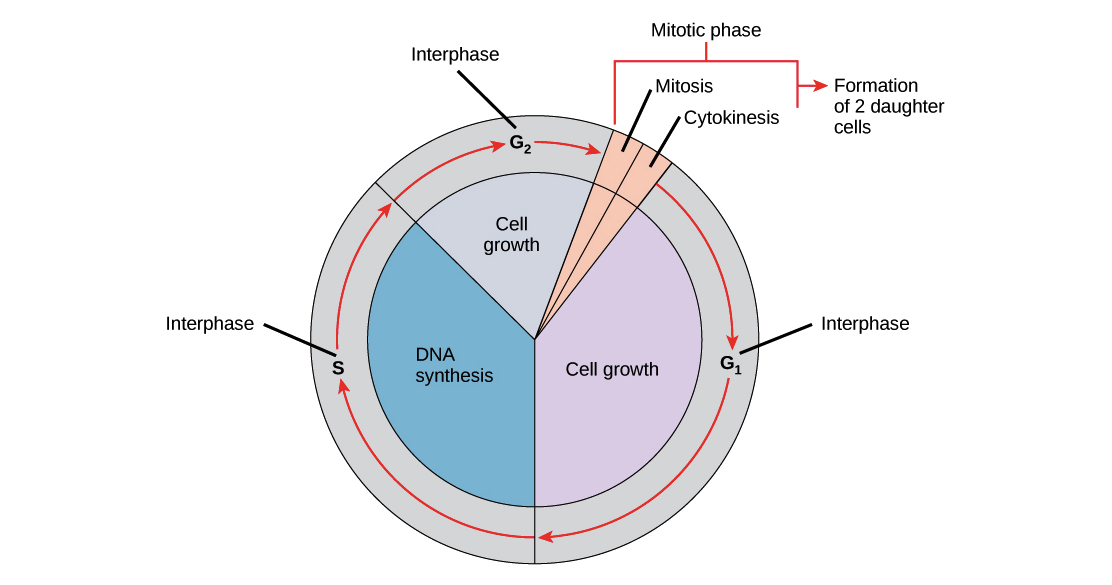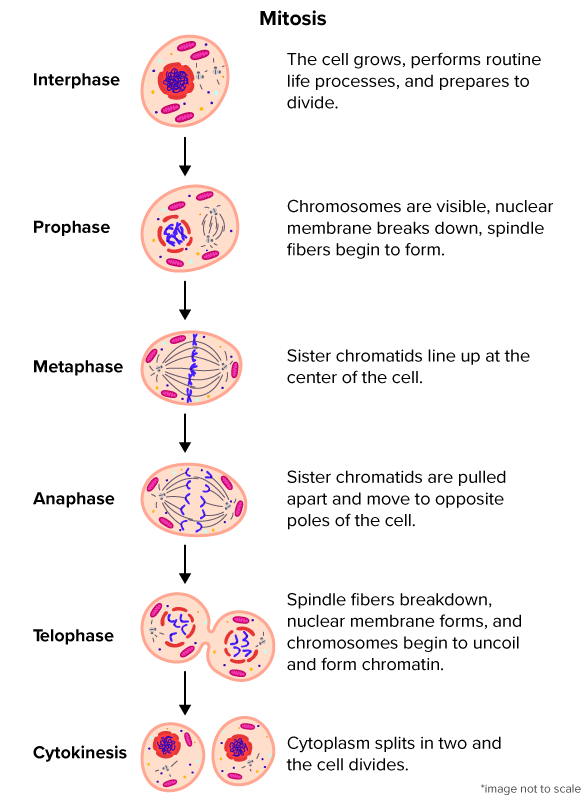Cell Cycle Study Guide
Check out awesome, educational VR rooms on Inspirit’s mobile app (available for iOS and Android devices)🤩
Introduction:
The cell cycle is also known as the cell division cycle. It is a series of processes in a cell as it grows and divides into two offspring daughter cells. The steps include duplicating DNA cells and separating the cytoplasm and other cellular contents into identical daughter cells. The mechanism of the cell cycle was first discovered by the scientist named Dumas and Prevost in 1824 while researching the cleavage of a frog’s zygote. As we shall see below, this cycle passes through a series of stages and steps to separate, divide, and produce new cells from the parent ones.
Various Stages and Phases of the Cell Cycle:
A eukaryotic cell cycle takes about 24hrs to complete one growth and division cycle, with Mitosis taking up 30% of this time. All eukaryotic cell cycles are divided into two main stages:
I) Interphase (G1, S, and G2)
II) Mitosis Phase
III) Cytokinesis
Before these 2 phases, there is another phase called the G0 Phase or Quiescence. This is a resting phase where all cells have left their cell cycles and stopped division. Some eukaryotic cells enter this phase and remain here for a very long time or even indefinitely performing assigned duties. This phase is a very common phase for the cells that are differentiated to their utmost capacities.
I) Interphase:
Here, the cell prepares for cell division by experiencing cell growth and replication of DNA. Interphase takes up about 90% of the time of the overall cycle, and it is divided into three stages:
1. G1 Phase: The Gap 1 phase is between mitosis and the replication of genetic materials. Here, the cell is active metabolically and continues its growth without DNA replication.
2. S Phase: This is also called the Synthesis phase. DNA replication occurs during this stage. A normal diploid somatic cell with a 2N complement of DNA at the beginning of the S phase acquires a 4N complement at its end. The process of RNA transcription, as well as protein synthesis in this phase, is almost NIL.
3. G2 Phase: The Gap 2 phase is a stage of rapid cell growth and protein synthesis, which helps prepare the cells for mitosis. There is spindle formation, cell organelle multiplication, etc.
II) Mitosis Phase:
It is also called the phase of equational division. In this phase, the cell undergoes reorganization and is divided into offspring. These offsprings have the same chromosome numbers as their parents. Mitosis plays a role in growth, tissue repair, and asexual reproduction. This phase is divided into the following phases:
1. Prophase features:
- Chromosomes condense themselves and become visible
- Each chromosome is composed of two sister chromatids
- Spindle fibers erupt from centromeres
- Nuclear membrane disappears
2. Metaphase features:
- Chromosomes line up at the plate of metaphase
- Centrioles with spindle fibers are at opposite ends of the cell
- The chromatids are attached to the spindle fibers
- Chromosomes are ready for division
3. Anaphase features:
- Sister chromatids are pulled to the opposite poles
- Condensation of the spindle fibers
- Chromatids split from the centromere
- Hence, a complete set of new chromosomes are formed
4. Telophase features:
- Nucleolus reappears
- Nucleolus is enlarged
- Brighter nuclei
- Formation of the nuclear envelope to create two new nuclei
Cytokinesis
This phase follows the mitosis phase. The cytoplasm undergoes division into two new daughter cells that are genetically identical to their parent cell. Cytokinesis in plant cells is more complex than animal cells.
In plant cells, a new cell wall is built between the daughter cells by the Golgi apparatus via a cell plate structure. Glucose and Golgi vesicles play a significant role in forming the cell wall.
In animal cells, cytokinesis occurs by a process known as cleavage through the formation of a cleavage furrow. The contraction of actomyosin filaments drives the separation of the cytoplasm into two cells.
Conclusion:
- Cell cycle is a process whereby a series of stages are undergone by the cells of living organisms.
- The result is the formation of two new daughter cells that are identical to each other and the parent cell.
- The various stages of the cell cycle are Interphase, M Phase – Prophase, Metaphase, Anaphase, and Telophase and Cytokinesis.
FAQs:
1. What are the four stages of the cell cycle?
In eukaryotes, the 4 stages of the cell cycle are G1 Stage, S Stage, G2 Stage, and M Stage.
2. What is the difference between the G1 and G2 stages in the cell cycle?
G1 is the first growth stage for cell growth and normal metabolic roles, whereas G2 is the second stage for cell growth and preparation for mitosis.
3. What happens in the G1 stage of cell growth?
The G1 phase is between mitosis and the replication of genetic materials. Here, the cell is active metabolically and continues its growth without DNA replication.
4. What are the 3 phases of the cell cycle?
The 3 phases of the cell cycle are:
- Interphase
- Mitosis
- Cytokinesis
5. Which phase comes between the G1 and G2 stages?
The S phase or the Synthesis phase comes between G1 and G2 in the cell cycle. The replication of DNA takes place during this stage.
We hope you enjoyed studying this lesson and learned something cool about Cell Cycle! Join our Discord community to get any questions you may have answered and to engage with other students just like you! Don’t forget to download our App to experience our funfour VR classrooms – we promise it makes studying much more fun! 😎
Sources:
- AP Bio Unit 4 Study Guide: Cell Cycle Note https://fiveable.me/ap-bio/unit-4/cell-cycle/study-guide/4ztGMFvp0v4KAzL65pOP Accessed on 30 Dec, 2021
- Mitosis- definition, purpose, stages, applications with diagram https://microbenotes.com/mitosis/ Accessed on 30 Dec, 2021



